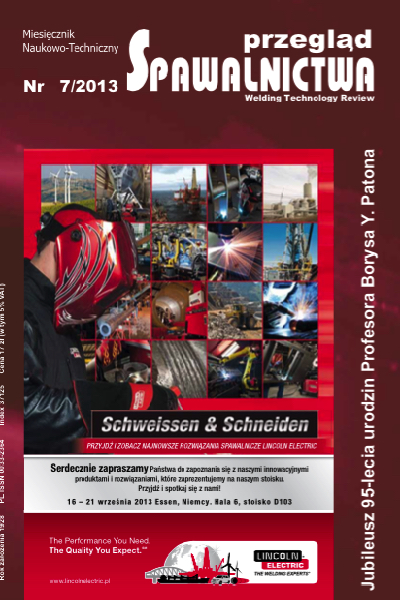Hybrydowe spawanie stali 41Cr4 z wykorzystaniem promieniowania laserowego i nagrzewania indukcyjnego
Main Article Content
Abstract
Technologia spawania laserowego jest jedną z najbardziej rozwijających się metod łączenia materiałów. Pomimo wielu zalet, takich jak wysoka jakość uzyskiwanych spoin, dobre właściwości mechaniczne, wąska strefa wpływu ciepła, w wybranych przykładach, z uwagi na wysoki gradient temperatury, wyniki są niekorzystne, gdyż dochodzi do pękania spoin na zimno. Rozwiązaniem tego problemu jest użycie hybrydowych metod spawalniczych, które, oprócz wiązki lasera, wykorzystują dodatkowe źródło energii, np. nagrzewanie indukcyjne. W artykule przedstawiono możliwości zastosowania nagrzewania indukcyjnego skojarzonego ze spawaniem stali oraz wyniki pomiarów rozkładów temperatury dla opracowanego wzbudnika indukcyjnego. Zaprezentowano również wyniki badań połączeń spawanych hybrydowo ze stali 41Cr4 (nr 1.7035).
Hybrid welding of 41Cr4 steel using laser beam and induction heating
Abstract
Laser beam welding is one of the most evolving methods of joining materials. Except for many advantages of this solution, such as high quality of the obtained seams, good mechanical properties, narrow heat affected zone, in particular cases, regarding high temperature gradient, the results are unsatisfying, because of cold seams cracking. The solution to this problem is the application of the hybrid welding methods, which, apart from laser irradiation, use additional source of energy, e.g. an induction coil. This article presents the potential for using inductive/induction heating associated with steel welding and shows the results of temperature distribution research for the developed induction coil. Additionally, it demonstrates the effects of laser hybrid welding for 41Cr4 (nr 1.7035) steel.
Downloads
Article Details
Creative Commons CC BY 4.0 https://creativecommons.org/licenses/by/4.0/
Welding Technology Review (WTR) articles are published open access under a CC BY licence (Creative Commons Attribution 4.0 International licence). The CC BY licence is the most open licence available and considered the industry 'gold standard' for open access; it is also preferred by many funders. This licence allows readers to copy and redistribute the material in any medium or format, and to alter, transform, or build upon the material, including for commercial use, providing the original author is credited.
References
Ferenc K.: Spawalnictwo, WNT, Warszawa 2007.
Kheronsky A., Lee H.: Induction heating for efficient laser applications, Advanced Materials & Processes, 2009, s
-42.
Fraunhofer Institut für Werkstoff- und Strahltechnik: Laser
Welding and Hybrid Welding Processes, Drezno 2004.
Vasilash G.: Laser processing meets induction heating,
Automotive Manufacturing & Production, 1997, s. 54-55.
Neumeyer J., Mach M., nacke B.: numerical Simulation of Induction Assisted Hybrid Welding Processes, International Scientific Colloquium, Ryga 2010, s. 97-102.
Mach M., Schülbe H., nacke B.: Modeling and optimization of induction assisted welding processes, International Scientific Colloquium, Ryga 2008, s. 215-220.
Pilarczyk J., Banasik M., Stano S., Dworak J.: Różnorodne techniki spajania laserowego wyniki badań i możliwości zastosowań, Biuletyn Instytutu Spawalnictwa, nr 5/2008, s. 46-53.
Rudnev V., Loveless D., Cook R.: Handbook of induction heating, Marcel Dekker, Inc., 2003, s. 627-674.
Zinn S., Semiatin S.: Elements of Induction Heating: Design, Control and Applications, ASM International, 1988, s. 32-41.
Ruffini R., nemkov V., Goldstein R.: Enhancing Induction Heating Processes by Applying Magnetic Flux Controllers, http://fluxtrol.com/, 1999.
Tavakoli M. H., Karbaschi H., Samavat F.: Influence of workpiece height on the induction heating process, Mathematical
and Computer Modeling, 2011, s. 50-58.
Ruffini R., Nemkov V., Goldstein R.: Influence of Magnetic
Flux Controllers on Induction Heating Systems, Computer
Simulation and Practice, http://fluxtrol.com/, 2001.
Tasak E.: Metalurgia spawania, Wydawnictwo JAK Andrzej
Choczewski, Kraków 2008.
http://www.dostal.com.pl/stal-do-ulepszania-cieplnego.html,
dostęp 30.04.2013 r.
